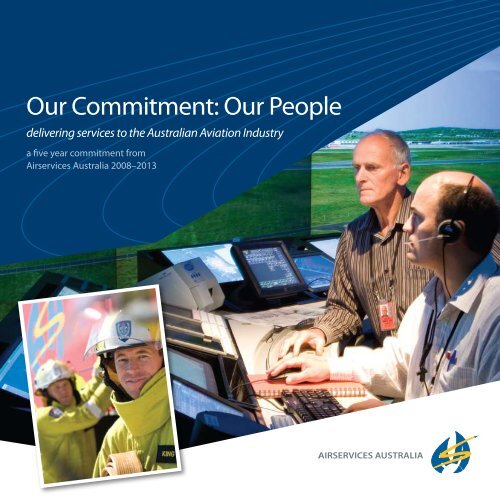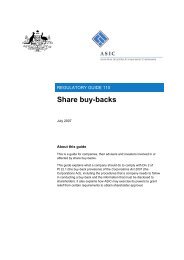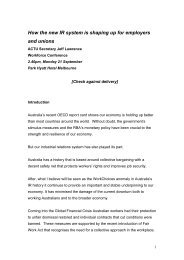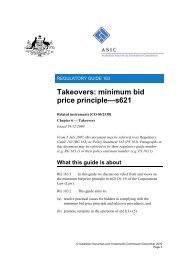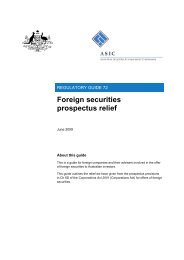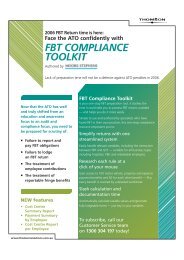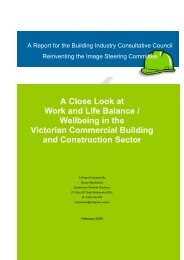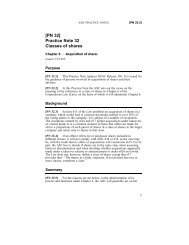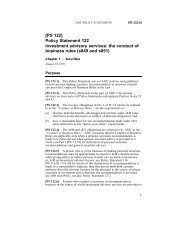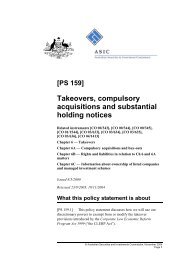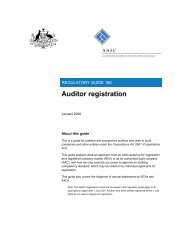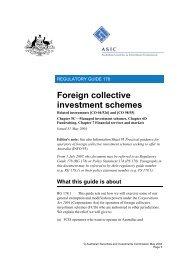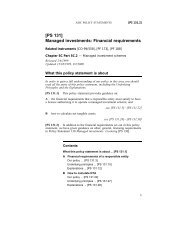Our Commitment: Our People - Thomson
Our Commitment: Our People - Thomson
Our Commitment: Our People - Thomson
Create successful ePaper yourself
Turn your PDF publications into a flip-book with our unique Google optimized e-Paper software.
<strong>Our</strong> <strong>Commitment</strong>: <strong>Our</strong> <strong>People</strong><br />
delivering services to the Australian Aviation Industry<br />
a five year commitment from<br />
Airservices Australia 2008–2013
CREDITS<br />
Published by Corporate Affairs<br />
Airservices Australia<br />
Alan Woods Building<br />
25 Constitution Avenue<br />
Canberra ACT 2600<br />
p 02 6268 4866 f 02 6268 5688<br />
www.airservicesaustralia.com<br />
COPYRIGHT<br />
Material in this publication is protected by copyright. Unless otherwise stated, no part of<br />
this publication may be reproduced or used for any purpose other than private personal use<br />
without the prior written consent of the copyright holder. Copyright in all materials and/or<br />
works comprising or contained within this publication remains with Airservices Australia and<br />
other copyright owners as specified.
<strong>Our</strong> <strong>Commitment</strong><br />
Australia has always been a leader in the field of aviation. From the pioneering<br />
beginnings of almost a century ago, aviation has helped to drive our economy<br />
and to draw our national social fabric together.<br />
We live on an island continent and aviation provides a bridge to the rest of<br />
the world. But, more than that, Australia is a land of vast distances and aviation<br />
has become an essential part of our infrastructure. Even in our electronic age,<br />
we still rely on aviation to reunite families and provide important personal links<br />
between businesses. Aviation supports popular sports and recreations, it carries<br />
mail and cargo between city centres and out to the bush, and it helps provide<br />
medical services to people across remote Australia.<br />
Airservices is continuing the proud tradition, established last century, of providing<br />
aviation services and infrastructure. <strong>Our</strong> purpose is to foster and promote civil<br />
aviation, both within and outside Australia. We manage 11% of the world’s airspace<br />
and over four million aircraft movements carrying some 47 million passengers<br />
each year. We provide aviation rescue and fire fighting services at 19 locations and<br />
maintain over 300 navigation aids ranging from radars and beacons through to<br />
state of the art satellite navigational systems. Australian aviation is projected to grow<br />
at about 3% per annum and we will need to control increased volumes of air traffic<br />
and provide ARFF services at more sites across the country, as well as upgrading<br />
existing services to handle larger categories of aircraft.<br />
Airservices’ ability to deliver these services to our customers is critically dependent<br />
on our people. This is especially true of the dedicated and highly skilled workforce<br />
in our operational areas: Air Traffic Control, Aviation Rescue and Fire Fighting, and<br />
Technical and Asset Services. We have a workforce of over 3000 people across<br />
Australia, the vast majority of whom are highly trained professionals.<br />
Like many businesses in Australia, including those in the aviation industry,<br />
we are facing the challenges of an ageing workforce and higher staff turnover<br />
among newer recruits. The strong Australian economy has driven growth in the<br />
aviation industry but, at the same time, the competition for new recruits has<br />
intensified. For instance, the continuing expansion of the resources sector has<br />
created keen competition for technical skills, especially in regional Australia.
But it is not just about our staff numbers. Leadership is critical to<br />
building our organisation’s capability and we have developed a<br />
strong leadership and management development programme<br />
that will provide a foundation for our future. We need a skilled<br />
workforce and we have established the Airservices Learning<br />
Academy to provide a first class training and development<br />
program for our operational, technical and managerial staff.<br />
This could be part of a solution to address the broader<br />
aviation skills shortage, together with industry.<br />
The challenge is very clear. Already, staff resources in many areas<br />
are stretched, and we have been forced to rely too much on<br />
overtime to cover the gaps. When sickness leads to unexpected<br />
absences, we are not always able to field a full team and this has<br />
led to reductions in services. While I must emphasise that safety<br />
has not been compromised, I do not find any reduction in service<br />
acceptable and as an organisation we are pursuing all options to<br />
ensure reliable service delivery.<br />
This booklet explains our business and outlines our strategy to<br />
achieve and maintain the workforce we will need over the next<br />
five years. We have analysed what that workforce should look<br />
like, not just to meet today’s requirement, but also to meet<br />
the demands in the future. <strong>Our</strong> strategy incorporates effective<br />
workforce planning, recruitment, career development, retention<br />
and succession planning. Where necessary, we will consider<br />
outsourcing and strategic partnerships, but we must be<br />
careful to retain our most skilled people if we are to stay at<br />
the leading edge. Part of our approach to addressing the<br />
current challenge of high competition in the labour market<br />
is recognising and rewarding our employees and offering<br />
them with an attractive career path at Airservices.<br />
Finally, but perhaps most crucially, we are building a culture<br />
of achievement. Airservices needs the support of its people<br />
if it is to be successful in ensuring service delivery over the<br />
long term, and this will be achieved by staff engagement<br />
and showing individuals how their efforts directly contribute<br />
to Airservices’ work.<br />
We are fostering an Airservices culture that strengthens<br />
communication, encourages unity and teamwork, celebrates<br />
success and achievement and is aligned with our future goals.<br />
We already have a strong safety-focussed professional culture<br />
in the organisation, and are now embarking on a program to<br />
encourage environmental thinking; these are steps along the<br />
road to a new organisational culture.<br />
Airservices takes pride that our services are important to<br />
our customers and to the people of Australia. This five-year<br />
workforce strategy demonstrates my commitment to<br />
delivering those services to our customers and my<br />
commitment to our staff to make Airservices a great<br />
place to work.<br />
Greg Russell<br />
Chief Executive Officer<br />
Airservices Australia<br />
June 2008<br />
2 Airservices Australia — <strong>Our</strong> <strong>Commitment</strong>: <strong>Our</strong> <strong>People</strong> 2008–13
The Evolution of the<br />
Australian Labour Market<br />
The developed world is experiencing great demographic<br />
change, characterised by declining birth rates, greater longevity<br />
and ageing populations. In western industrialised nations like<br />
Australia, these shifts are contributing to labour market skill<br />
shortages and, in combination with social and technological<br />
changes and the wider forces of globalisation, are creating<br />
major challenges for employers.<br />
Ageing Population<br />
Australia’s population is ageing and this trend is expected<br />
to continue as a result of low levels of fertility and increasing<br />
life expectancy. The median age of Australia’s population,<br />
36.4 years at June 2004, is projected to increase to between<br />
39.9 years and 41.7 years in 2021 and to between 44.6 years<br />
and 48.2 years in 2051.<br />
Generational Issues<br />
While there are increasing numbers of older people in<br />
Australia as a percentage of population, Generations X and Y<br />
already comprise over 40 percent of Australia’s population.<br />
(See Figure 1) and are the emerging generation of workers.<br />
David Forsyth, Chairman<br />
Chairman’s Awards for<br />
Professional Excellence<br />
The Chairman’s Awards for Professional Excellence<br />
recognise employees who have made an exceptional<br />
contribution, beyond their normal duties, to their work<br />
and to the organisation.<br />
The categories for which awards are presented are:<br />
• Air Environment Management<br />
• Air Safety Management<br />
• Air Traffic Control<br />
• Engineering<br />
• Aviation Rescue and Fire Fighting<br />
Winners of the 2008 awards are introduced in<br />
profile throughout the document.<br />
Airservices Australia — <strong>Our</strong> <strong>Commitment</strong>: <strong>Our</strong> <strong>People</strong> 2008–13 3
In 20 years time, even the youngest Baby Boomers will be<br />
reaching retirement age, closely followed by the oldest of the<br />
Generation X’ers while the Generation Y’s and younger X’ers<br />
will be in the prime of their careers. From an employment<br />
perspective, the older Y’s — the 20 to 26 year olds — already<br />
have a labour force participation rate of around 90%, which is<br />
second only to the X’ers in their 30’s and 40’s. 1<br />
The increasing proportion of Generation Y employees within the<br />
workforce is posing some additional challenges to employers.<br />
Their employment outlook and expectations are shaped primarily<br />
by an early introduction to computer technology, the internet,<br />
rapid communication and relatively affluent baby boomer<br />
parents. The experience across industries indicates that this<br />
generation of workers is demanding more flexibility in their<br />
roles, higher rewards, freedom to advance their professional<br />
learning and development, quicker succession and better<br />
work-life balance than older employees.<br />
The age cohort that comprises Generation Y has also grown<br />
up during an economically prosperous period and has only<br />
experienced the employment conditions of a tight labour<br />
market that favours employees. If their expectations are not<br />
met, these employees readily move on to the next challenge.<br />
A poor retention rate of Generation Y employees has lead to<br />
a perception that they are substantially harder to manage<br />
than any preceding generation. 2<br />
Figure 1: Australia’s Generations 3<br />
Description Born Age Population (m) % of Pop’n<br />
Builders Before 1946 61+ 3.5 17.0<br />
Baby Boomers 1946–1964 42–60 5.3 26.0<br />
Generation X 1965–1979 27–41 4.4 21.5<br />
Generation Y 1980–1994 12–26 4.2 20.5<br />
Generation Z 1995–2009 Under 12 3.1 15.0<br />
1 ABS — Australian Labour Marker Statistics, Cat 6105, January 2006<br />
2 “Making Talent a Strategic Priority”, The McKinsey Quarterly, 21 January 2008<br />
3 ABS Population Pyramid 2006 and McCrindle Research Study 2006<br />
4 Airservices Australia — <strong>Our</strong> <strong>Commitment</strong>: <strong>Our</strong> <strong>People</strong> 2008–13
Job Loyalty<br />
The strong labour market and competition for skills is challenging<br />
traditional perceptions about the loyalty of mature workers.<br />
A recent survey conducted by the Australian recruitment and<br />
networking site, Linkme.com.au, has found that 82 percent of<br />
Australian employees aged between 41 and 55 are currently<br />
seeking to change their job. The study also found that 80 percent<br />
of employees earning between $80,000 and $99,000 are seeking<br />
alternative employment opportunities as well, indicating that<br />
job loyalty of the more affluent is also changing. 4<br />
This adds increasing pressure on employers to ensure that they<br />
are perceived to be a good employer, offering existing and<br />
prospective employees a great place to work.<br />
Jobs Boom Discouraging University Enrolment<br />
The booming job market in Australia appears to be influencing an<br />
increasing number of young people to bypass tertiary education<br />
in favour of full-time employment. Applications for university<br />
placement are down and fewer students are completing year 12.<br />
In 2001, just 59 percent of 17-year-olds in Australia had completed<br />
their Year 12 Certificate or an equivalent qualification. For those<br />
who did complete Year 12, only 40 percent went on to complete<br />
further tertiary studies. 5<br />
Furthermore, TAFE courses are now attracting higher<br />
demand, which is also contributing to the dropping<br />
numbers of university enrolments. These issues are all<br />
adding to the current skills shortage, with particular labour<br />
shortages expected to continue in disciplines including the<br />
sciences and engineering. The output of skilled professionals<br />
is shrinking while the demand continues to grow. 6<br />
4 “Gen Y Fever Hits the Job Market in 2008”, Linkme.com.au, 14 January 2008<br />
5 “20:20 Australia Series”, Hudson, August 2004<br />
6 “Unis Bypassed as Jobs Beckon”, The Age, 14 January 2008<br />
Airservices Australia — <strong>Our</strong> <strong>Commitment</strong>: <strong>Our</strong> <strong>People</strong> 2008–13 5
Skills Shortages<br />
The strong Australian economy, coupled with demographic<br />
pressures due to the ageing population, has led to historically<br />
low unemployment and a high labour force participation rate.<br />
Current trends indicate that the skilled labour shortage is<br />
unlikely to ease in the near future. A recent survey conducted<br />
by Hudson, of close to five thousand Australian organisations,<br />
found that half have experienced a rise in recruitment expenses<br />
of up to fifty percent, partly due to the increased time required<br />
to successfully recruit new employees.<br />
As early as 2005, the Australian Industry Group reported<br />
Australian companies rated the inability to secure skilled staff and<br />
the high cost of skilled labour as the two most significant barriers<br />
to company success. About half the companies surveyed also<br />
reported difficulties in retaining skilled staff.<br />
The challenges around securing skilled labour were particularly<br />
significant for tradespeople, technicians, paraprofessionals and<br />
engineering professionals (see Figure 2), and this is reflected in<br />
the recruitment challenges facing our Technology and Asset<br />
Services group. However, the Air Traffic Control and Aviation<br />
Rescue and Fire Fighting groups are continuing to be highly<br />
competitive in the workplace market, with many applicants<br />
for every position advertised.<br />
Figure 2: Difficulties Securing Skills — by Occupation, Australian Companies, 2005<br />
Trades<br />
Technicians and paraprofessionals<br />
Engineering professionals<br />
Managers<br />
Apprentices and trainees<br />
Labourers and process workers<br />
Other professionals<br />
Clerical and administrators<br />
IT professionals<br />
0 10 20 30 40 50 60 70 80<br />
% of sample agreeing<br />
6 Airservices Australia — <strong>Our</strong> <strong>Commitment</strong>: <strong>Our</strong> <strong>People</strong> 2008–13
Airservices’ Workforce<br />
Airservices’ workforce is long-tenured and as a direct<br />
consequence of this we rely increasingly on mature-aged<br />
employees (45 years and over) who represent 48 percent<br />
of our ongoing workforce.<br />
Figure 3 shows the composition of the workforce by<br />
generation, dominated by Baby Boomers and Gen-X.<br />
Much of our corporate knowledge resides with the<br />
Builder generation, which is approaching retirement.<br />
Figure 3: Airservices Breakdown by Generation<br />
Airservices Employee Breakdown by Generation — as at 30 April 2008<br />
Ken Owen<br />
2008 Chairman’s Award for Professional Excellence<br />
— Environment<br />
Ken joined Airservices in August 1995 and<br />
currently works as an Environment Specialist<br />
within Corporate Affairs.<br />
Ken is a highly regarded technical advisor and<br />
he plays an active role in international environment<br />
fora, including ICAO. His contribution to air<br />
environment management is second to none.<br />
Ken was instrumental in developing Environment<br />
Principles for minimising the impact of aircraft<br />
operations — he developed the framework for this<br />
in the absence of legislative or regulatory guidance.<br />
Builders<br />
Baby Boomers<br />
Generation X<br />
Generation Y<br />
“Aviation environment has been an interesting,<br />
challenging and rewarding area to work in for the last<br />
13 years and with the increasing focus on environmental<br />
issues, in particular climate change, it is only becoming<br />
a more exciting area to be involved in”.<br />
— Ken Owen.<br />
Airservices Australia — <strong>Our</strong> <strong>Commitment</strong>: <strong>Our</strong> <strong>People</strong> 2008–13 7
Figure 4 shows Airservices’ Age Profile. The challenge of<br />
our maturing workforce is clearly evident, with many of<br />
our staff being members of superannuation schemes<br />
that offer strong financial incentives to retire at the age<br />
of 55, or earlier. The under-35 age group is under-represented,<br />
reflecting both the increased competition for younger<br />
workers in the current recruitment market and higher<br />
turnover rates in more recent recruits.<br />
Figure 5 shows Airservices’ turnover rates by tenure over the<br />
previous five years and indicates that turnover is greatest in<br />
low tenured employees — those with less than three years<br />
employment with Airservices — and the turnover rates of<br />
employees in this group have increased over recent years.<br />
However, turnover rates do not yet pose a serious problem in<br />
our operational areas, as the separation rates there are still very<br />
low in comparison to other industries. The higher turnover is<br />
most evident in more junior staff and non-professional roles.<br />
Figure 4: Age Profile (Airservices Australia Total)<br />
Airservices’ Age Profile at 30 April 2008<br />
Headcount<br />
1400<br />
1200<br />
1000<br />
800<br />
600<br />
400<br />
200<br />
Figure 5: Airservices’ Employee Initiated Separation Rate<br />
by Tenure Profile (TP) as at 30 April 2008<br />
Employee-Initiated Separation Rates<br />
25%<br />
20%<br />
15%<br />
10%<br />
5%<br />
0<br />
05/06<br />
Workforce Planning<br />
In 2006, Airservices commenced strategic workforce planning in<br />
order to ensure that we have the right mix of skills and capability<br />
within the organisation to support the future needs of the<br />
business. <strong>Our</strong> workforce planning methodology is based on<br />
quantitative analysis of our workforce and involves examination<br />
of the internal and external environment to identify the likely<br />
impact of any new technology and planned projects on workforce<br />
numbers and requisite skills. This demand information is coupled<br />
with supply projections, based on pending retirements and<br />
historical attrition rates, in order to develop a forecast of potential<br />
risk areas and workforce shortages or surpluses. Gaps identified<br />
through this process inform the development of workforce<br />
strategies for the business.<br />
A new Workforce Plan for Airservices covering the period<br />
2008–2013 is currently under development and is due for<br />
completion by the end of June 2008. We intend to review<br />
and update the Plan on an annual basis. This booklet focuses<br />
on our operational workforce, but our plan covers the whole<br />
organisation. The skilled people in our corporate areas are<br />
vital for the effectiveness of the organisation as a whole.<br />
Airservices Learning Academy<br />
One of the initiatives to address the skills and capability gaps<br />
is a greater focus on the internal learning and development<br />
of our staff. This will be done through the expansion of our<br />
current Melbourne training facility into the Learning Academy.<br />
The Academy will incorporate air traffic control training, technical<br />
training and rescue and fire fighting training, as well as leadership,<br />
management, and safety training. The facility will offer a dynamic<br />
curriculum that responds to the organisation’s changing skills<br />
requirements over time.<br />
Airservices Australia — <strong>Our</strong> <strong>Commitment</strong>: <strong>Our</strong> <strong>People</strong> 2008–13 9
Air Traffic Control Group<br />
The Air Traffic Control (ATC) Group is the major service delivery arm of Airservices, representing almost 40% of all employees.<br />
Over 1200 ATC staff, including non operational staff, are deployed nationally to provide air traffic control, flight information<br />
and aeronautical information services. They work in our two major centres at Melbourne and Brisbane, in four terminal<br />
control units at Cairns, Sydney, Adelaide and Perth, and in 26 towers across regional and urban Australia (see Figure 6).<br />
Airservices has also established a separate National Operations Centre to deliver strategically coordinated air traffic<br />
flow management involving ATC, airlines and airports.<br />
Figure 6: Location of our air traffic control centres and towers<br />
Cairns<br />
Alice Springs<br />
Archerfield<br />
Hamilton Island<br />
Mackay<br />
Rockhampton<br />
Maroochydore<br />
Brisbane<br />
Coolangatta<br />
Perth<br />
Jandakot<br />
Adelaide<br />
Parafield<br />
Albury<br />
Launceston<br />
Tamworth<br />
Canberra<br />
Sydney<br />
Bankstown<br />
Camden<br />
Melbourne<br />
Avalon<br />
Essendon<br />
Moorabin<br />
Hobart<br />
Coffs Harbour<br />
10 Airservices Australia — <strong>Our</strong> <strong>Commitment</strong>: <strong>Our</strong> <strong>People</strong> 2008–13
Air traffic controllers have traditionally maintained long careers<br />
at Airservices. While the average tenure of ATCs is slowly trending<br />
down, it is still around 17 years and three out of four ATCs have<br />
more than 10 years service. <strong>Our</strong> workforce is relatively mature<br />
compared to the rest of the workforce, with an average age of<br />
42 years.<br />
35% of our ATC staff are within the age range of 35 to 45 years,<br />
with 37% between 45 to 55 years. Only 8% are aged over 55<br />
(see Figure 7), reflecting current financial incentives for<br />
retirement at that age.<br />
Careful workforce planning is crucial, as training ab initio recruits<br />
to operational competency takes around 18 months. This has<br />
hampered our ability to respond quickly to emerging controller<br />
shortages. An important interim strategy, which we have adopted<br />
in 2007 and 2008, involves attracting experienced controllers who<br />
can be retrained on the Australian air traffic system in a third of<br />
the time, or less. These recruits are generally controllers who have<br />
been working overseas, including some Australian controllers<br />
who have taken the opportunity to return home.<br />
Figure 7: Age Profile — Air Traffic Control Group<br />
Airservices EOP Headcount<br />
Headcount<br />
500<br />
450<br />
400<br />
350<br />
300<br />
250<br />
200<br />
150<br />
100<br />
50<br />
0<br />
ATC Workforce Strategy<br />
We have projected the ATC workforce demand for the next 5 years.<br />
Broadly, we expect the demand for ATC will remain stable as much of<br />
the projected increase in passenger numbers are being met through<br />
the introduction of larger aircraft and do not lead to a direct increase<br />
in ATC workload. However, we are expecting traffic growth to lead to<br />
the introduction of new services and increased staffing levels in some<br />
locations. The principal challenge is maintaining our staffing numbers<br />
as the expected rate of retirement increases, from the very low numbers<br />
historically, to match the number of resignations. The total number<br />
is expected to rise to around 50–60 per annum (see Figure 8).<br />
<strong>Our</strong> strategy to address this involves increasing our recruitment,<br />
refining our training and improving our management of staff.<br />
Employees (FTE)<br />
Figure 8: Nett ATC attrition through retirement/resignation<br />
400<br />
350<br />
300<br />
250<br />
200<br />
150<br />
100<br />
50<br />
0<br />
To 08/09<br />
To 10/11<br />
To 12/13<br />
Recruitment<br />
Baseline Business — Total (Gap)<br />
Planned Future — Total (Gap)<br />
<strong>Our</strong> service provision model has traditionally been contingent upon<br />
overtime to cover unplanned staff absence — this model must change.<br />
We have now reviewed our staffing levels and will increase our<br />
recruitment to better assure customer service levels.<br />
Airservices has reshaped and streamlined the ATC recruitment process.<br />
In particular, we have reviewed our recruitment selection tools to reflect<br />
the changing nature of the air traffic controller’s job with the aim of<br />
improving the proportion of recruits who graduate successfully.<br />
<strong>Our</strong> overall target is to increase our recruitment and training capability to<br />
build a workforce that will ensure robust service provision (see Figure 9).<br />
We plan to recruit between 80 and 100 ab initio ATC trainees per annum<br />
over the next 5 years, up from around 40 in previous years. In view of<br />
the global shortage of air traffic controllers, we will not pursue further<br />
recruitment of experienced international controllers, but will instead<br />
focus on building our training capability within Australia.<br />
Employees<br />
Demand/Supply Figure 9: Demand/Supply Comparison for for Air Air Traffic Traffic Controllers<br />
1400<br />
1200<br />
1000<br />
800<br />
600<br />
400<br />
200<br />
0<br />
07/08 To 08/09 To 09/10 To10/11 To 11/12<br />
Fiscal Year<br />
Baseline Business<br />
Planned Future<br />
Retirement/Resignations Recruitment<br />
To 12/13<br />
12 Airservices Australia — <strong>Our</strong> <strong>Commitment</strong>: <strong>Our</strong> <strong>People</strong> 2008–13
Training and development<br />
Airservices recognises the value of investment<br />
in our people, not only in individuals but in<br />
the systems and tools that support<br />
their ongoing development.<br />
The evolution of Airservices Learning<br />
Academy is the cornerstone of our<br />
capability for developing our people. The<br />
consolidation of our training into the Learning<br />
Academy enables a consistent and focussed<br />
approach to creating a sustainable, worldclass<br />
workforce.<br />
Airservices has recently acquired a $16 million<br />
tower visual simulator and commenced a<br />
multi-million dollar replacement program for<br />
the en-route simulator. These tools provide<br />
leading-edge capability to enhance the skills<br />
of ATC staff.<br />
A review of our training curriculum and<br />
processes has commenced to ensure we are<br />
gaining maximum value from our investment<br />
in these new tools.<br />
Work-life balance<br />
Deploying our people in an efficient manner<br />
will always require balancing work-life needs<br />
with business needs. We’ve invested in new<br />
rostering tools to help manage this process<br />
and we intend to rollout this capability<br />
nationally during 2008.<br />
Together with new stand-by arrangements,<br />
the rostering changes should reduce reliance<br />
on over-time and help assure planned leave.<br />
Jennifer Birdsall<br />
Adam Watkin<br />
2008 Chairman’s Award for Professional Excellence — Air Traffic Control (ATC)<br />
Jennifer has worked in a number of positions since joining Airservices in 1994 including<br />
time as an Air Traffic Controller. She is currently the manager of the National Operations<br />
Centre and CTMS (Central Traffic Management System).<br />
Jennifer has displayed an extraordinary commitment to improving the sequencing<br />
and on time performance of flights through the development and implementation<br />
of such tools as CTMS and ALOFT (A Long-Range Optimal Flow Tool).<br />
Jennifer demonstrated dedication and leadership in aiming to provide best possible<br />
service to airlines — her work in this area has contributed to significant fuel savings<br />
and a reduction in aircraft emissions for our key customers.<br />
“I am delighted to receive a Chairman’s award. For me this award is really<br />
recognition of the tremendous work of my entire team here in the NOC.<br />
I’ve been honoured to work with such a great team”<br />
— Jennifer Birdsall.<br />
Adam joined Airservices in 1985 as a Flight Data Coordinator. He now works as an<br />
Air Traffic Controller for the Air Traffic Control unit.<br />
Adam worked in his own time to prepare a one-off Data Link course for 8 Indonesian<br />
controllers which involved extensive detail and simulation.<br />
Recognised as a data-Link expert Adam also developed a data-link handbook and<br />
continues to focus on improving Airservices use of technology.<br />
“I enjoy the challenge of trying to provide the most efficient service to as many<br />
aircraft as possible and I am proud to be recognised in a forum like this at least<br />
in some part for my efforts in achieving this”<br />
— Adam Watkins.<br />
Airservices Australia — <strong>Our</strong> <strong>Commitment</strong>: <strong>Our</strong> <strong>People</strong> 2008–13 13
Career Management<br />
We have developed an ATC Career Model to provide a broader<br />
range of opportunities and development for our people.<br />
We share the responsibility for career planning with our staff<br />
and will give them the opportunity to undergo development that<br />
will enhance their career paths, providing them with rewarding<br />
and diverse opportunities both technically and professionally.<br />
Previously, ATC careers tended to be limited to particular<br />
professional specialisations. We are breaking down these<br />
organisational barriers so that staff have options to develop across<br />
all ATC skill sets. The ATC Career Model recognises that ATCs may<br />
wish to move both laterally and vertically within the operational<br />
areas, as well as into non-operational and management roles.<br />
Over time, an individual’s aspirations may change and the<br />
model is designed to accommodate changing preferences.<br />
The ATC Career Model does not define specific career pathways<br />
or impose prerequisites on specific roles; it is about identifying<br />
opportunity for development and enhancement and creating<br />
the environment in which ATCs can experience a broader<br />
and more satisfying working life.<br />
14 Airservices Australia — <strong>Our</strong> <strong>Commitment</strong>: <strong>Our</strong> <strong>People</strong> 2008–13
Retention<br />
Over the past 12 months we’ve been working with our people to<br />
further explore transition-to-retirement options. The existing early<br />
retirement conditions need not be a barrier and we are developing<br />
a range of employment options that can match employee and<br />
business needs without losing valuable skills and experience.<br />
We have also recognised the need for more flexible working<br />
arrangements that allow our staff to better manage family and<br />
community responsibilities.<br />
Delivering our Organisational Leadership Model in ATC Group<br />
The application of the Airservices leadership model within ATC is<br />
critical to instilling a consistent approach to leadership within the<br />
group, to align our processes and systems and to ensure we have<br />
the right people for the role.<br />
<strong>Our</strong> major focus of 2007 was to implement a group structure<br />
more directly aligned to service delivery. While some aspects of<br />
the implementation are continuing, we are on target to achieve a<br />
structure that provides clearer lines of accountability and reduces<br />
the number of management layers between line controllers and<br />
senior management.<br />
As part of the Airservices leadership initiatives, we are also<br />
delivering management and leadership training, tailored to ATC<br />
requirements, to our front-line ATC managers. This has already<br />
provided visible benefits, with new managers more confident<br />
and capable in their roles.<br />
Staff forums identified inconsistent understanding of issues by both<br />
managers and staff. In response, we are implementing initiatives to<br />
improve communications within the organisation. We will ensure<br />
that we are providing channels for clear communication, in both<br />
directions, to ensure that important messages get through.<br />
Airservices Australia — <strong>Our</strong> <strong>Commitment</strong>: <strong>Our</strong> <strong>People</strong> 2008–13 15
Case study: Brisbane Green RNP Trial<br />
Airservices Australia has a long tradition of innovation and collaboration<br />
to meet the needs of the aviation industry, particularly in the advancement<br />
of safety, efficiency and the environment. In 2006, Airservices Australia<br />
and Naverus Inc., in close collaboration with Qantas Airways and the<br />
Civil Aviation Safety Authority of Australia (CASA), began work to<br />
implement high precision, performance-based instrument approach<br />
and departure procedures within Australia.<br />
These procedures, based upon Required Navigation Performance<br />
(RNP), are designed to take advantage of the sophisticated navigational<br />
capability of modern aircraft. Initially implemented at terrain challenged<br />
locations such as Juneau, Alaska, RNP approaches and departures are now<br />
demonstrating real safety, efficiency and environmental benefits at a wide<br />
range of airports where modern aircraft operate.<br />
The rollout of RNP approach and departures is in progress for 15 airports<br />
across Australia, including the milestone “Brisbane Green” project at<br />
Brisbane International Airport. The Brisbane Green Project is a world-first<br />
integration of Required Navigation Performance (RNP) approaches and<br />
departures into a busy international airport. This trial was established to<br />
determine the most effective way to integrate RNP at a busy international<br />
airport supporting mixed (RNP and conventional) operations:<br />
The objectives of the project were to:<br />
• develop ATC and flight crew operating procedures;<br />
• identify, measure and report the benefits and costs of RNP<br />
to all stakeholders;<br />
• identify, resolve and document issues and consequences; and<br />
• gather a body of data to support the development by ICAO<br />
of terminal area RNP separation standards.<br />
The figure above shows the predictability<br />
of RNP approach paths (green) by contrast<br />
with the significant variation to flight path<br />
for conventional procedures (red), which<br />
lead to increased track miles and<br />
controller workload.<br />
In the first twelve months of the project, over 15,500 RNP procedures<br />
were conducted, including more than 8,000 approaches. The results<br />
included a 32,000 km reduction in distance flown on approach, saving<br />
more than 200,000 kg of fuel and reducing carbon dioxide emissions<br />
by an estimated 650,000 kg.<br />
16 Airservices Australia — <strong>Our</strong> <strong>Commitment</strong>: <strong>Our</strong> <strong>People</strong> 2008–13
Aviation Rescue Fire Fighting Group<br />
Aviation Rescue & Fire Fighting (ARFF) Group provides aviation<br />
and structural fire fighting and rescue services to airlines in the<br />
vicinity of aerodromes at 19 of Australia’s busiest airports.<br />
At the major capital city locations, fire fighters operate in<br />
a complex environment due to the high tempo of aircraft<br />
movements, the broad range of aircraft types (from SAAB<br />
turbo props to the new A380), the variety and size of buildings,<br />
and the volume of passengers. The focus is on maintaining the<br />
business continuity of airlines and airports through providing<br />
a highly reliable and responsive service and being able to<br />
handle multiple responses concurrently. In Sydney alone,<br />
ARFF responded to some 1600 aircraft, first aid and building<br />
alarms last year, as well as to a variety of hazardous material<br />
spills and motor vehicle accidents.<br />
ARFF Workforce<br />
<strong>Our</strong> ARFF workforce consists of over 500 dedicated professional<br />
aviation fire fighters, highly trained in public safety, fire fighting<br />
operations and management. About 50% of our people are<br />
located in the major capital city locations of Sydney, Melbourne,<br />
Brisbane and Perth, with a further 25% in Adelaide, Darwin,<br />
Coolangatta and Cairns. The nature of operations at the other<br />
less busy but often remote airports around Australia provides<br />
ARFF the flexibility to support the aviation industry and local<br />
communities in a variety of ways not possible at the busier ports.<br />
At Defence locations, such as Townsville, our people require<br />
specialised knowledge and skills to manage the unique risks<br />
associated with RAAF activities.<br />
<strong>Our</strong> aviation fire fighters are supported by emergency vehicle<br />
technicians who maintain a fleet of more than 75 specialised,<br />
high-performance aviation fire vehicles, water rescue craft and<br />
fire and emergency response equipment, ensuring we are<br />
always ready to respond.<br />
Airservices Australia — <strong>Our</strong> <strong>Commitment</strong>: <strong>Our</strong> <strong>People</strong> 2008–13 17
ARFF Recruitment and Training<br />
Airservices has consistently attracted strong interest from<br />
people wishing to pursue a career in aviation fire fighting,<br />
in spite of the generally competitive labour market.<br />
However, we are experiencing attraction challenges in<br />
some regions. We have an ageing ARFF workforce and<br />
younger age cohorts are under-represented when<br />
compared with the Australian labour market.<br />
The selection process to become a fire fighter includes<br />
aptitude and behavioural assessments as well as physical<br />
and functional testing to help us select recruits who<br />
demonstrate the enthusiasm, competency and capability<br />
to do the job.<br />
The successful recruits embark on a comprehensive eight<br />
week training program at our Learning Academy, aiming to<br />
achieve the Certificate 2 in Public Safety (Fire Fighting and<br />
Emergency Operations). Theory coupled with practical fire<br />
suppression exercises introduces recruits to the serious side<br />
of aviation rescue fire fighting. The course is both mentally<br />
and physically gruelling, to prepare recruits for the challenges<br />
they will face in the fire station.<br />
On completion of Certificate 2, the new recruits are<br />
introduced to their team and their Fire Commander begins<br />
their familiarisation with the procedures and equipment<br />
specific to their location. As our locations have varying<br />
levels of complexity, it can take up to 2 years to attain the<br />
Certificate 3 qualification to become a fully operational fire<br />
fighter, able to undertake multiple tasks at the fire station.<br />
Pete McMahon<br />
2008 Chairman’s Award for Professional Excellence<br />
— Aviation Rescue and Fire Fighting (ARFF)<br />
Pete joined Airservices in February 2004 and is now a<br />
Leading Aviation Fire Fighter within Airservices Aviation<br />
Rescue and Fire Fighting (ARFF) service.<br />
Pete has developed a computer program called PREP<br />
that enables ARFF to gather information about a building<br />
including storage of hazardous chemicals, location of fire<br />
hydrants and emergency exits.<br />
Pete’s work has the potential to revolutionise the<br />
implementation of emergency management not<br />
only for ARFF but also other fire services.<br />
“I relish what I do at Airservices and get a great deal<br />
of satisfaction out of knowing that my initiative and<br />
enthusiasm is encouraged, not suppressed. Airservices<br />
Australia has provided me with a great opportunity to<br />
be successfully involved with many tasks over and<br />
above my core duties”<br />
— Pete McMahon.<br />
18 Airservices Australia — <strong>Our</strong> <strong>Commitment</strong>: <strong>Our</strong> <strong>People</strong> 2008–13
ARFF Career Development<br />
Figure 10: ARFF Staff Demographic Profile<br />
Airservices ARFF EOP Headcount<br />
Airservices offers a variety of opportunities for aviation<br />
fire fighting career progression. After entering as a trainee<br />
fire fighter, employees progress through the public safety<br />
training qualifications and ranks of operational fire fighting<br />
and officer responsibilities.<br />
The ARFF career model offers many and varied opportunities<br />
to advance in both operational and non-operational positions,<br />
with the ultimate potential to reach the level of Superintendent<br />
in the field.<br />
We are also investigating opportunities to conduct more<br />
specialised training in conjunction with Victorian state<br />
emergency agencies.<br />
Headcount<br />
300<br />
250<br />
200<br />
150<br />
100<br />
50<br />
0<br />
Workforce Challenges<br />
<strong>Our</strong> two main areas of challenge over the next five years will be to meet<br />
the growing demand for ARFF services and to manage the transition<br />
and turnover of our officers.<br />
With the introduction of larger category aircraft such as the A380, ARFF<br />
operations in Sydney, Melbourne, Brisbane and Perth will be upgrading<br />
to Category 10. Many regional ports, particularly in Western Australia and<br />
Queensland, are experiencing significant growth in passenger numbers<br />
and larger aircraft types, necessitating an increase in staff numbers.<br />
Based on the growth in domestic and international aviation traffic, we<br />
are planning to open a number of new services and facilitate category<br />
upgrades at a number of our locations over the next five years. However,<br />
we are mindful of high growth rates being experienced at a further six<br />
locations which will be monitored closely during this period. The location<br />
of current and potential new ARFF stations is shown in Figure 11.<br />
Meeting this planned growth will involve increasing our operational<br />
workforce by 60%, from around 550 today to approximately 900 in<br />
2013, as well as significant investment in fire station infrastructure, fire<br />
fighting trucks and equipment. Furthermore, our traditional recruitment<br />
methodology and training capacity for trainee fire fighters will not<br />
bridge the gap until 2013. Therefore, ARFF has introduced systematic<br />
workforce planning coupled with new approaches to recruitment,<br />
retention and training.<br />
Figure 11: Location of our (current, planned and potential) ARFF services to 2012.<br />
Darwin<br />
Port Hedland<br />
Karratha<br />
Perth<br />
Broome<br />
Alice Springs<br />
Ayers Rock<br />
Adelaide<br />
Albury<br />
Cairns<br />
Dubbo<br />
Wagga Wagga<br />
Launceston<br />
Townsville<br />
Proserpine<br />
Hamilton Island<br />
Mackay<br />
Rockhampton<br />
Hervey Bay<br />
Maroochydore<br />
Brisbane<br />
Coolangatta<br />
Ballina<br />
Sydney<br />
Canberra<br />
Melbourne<br />
Avalon<br />
Hobart<br />
Coffs Harbour<br />
20 Airservices Australia — <strong>Our</strong> <strong>Commitment</strong>: <strong>Our</strong> <strong>People</strong> 2008–13
Maintaining our Officer workforce<br />
Figure 12: Age Profile of Fire Fighters and Senior Officers<br />
Around 50% of ARFF Officers are 50 years of age or over,<br />
and nearly 20% are over 55 (see Figure 12).<br />
We expect that 120 of our fire fighters and fire officers<br />
will retire within the next five years. We have 133 officers<br />
in our ranks today but will require at least an additional<br />
56 officer positions within five years and will need to<br />
replace about 60 who have indicated their intention<br />
to retire.<br />
Headcount<br />
90<br />
80<br />
70<br />
60<br />
50<br />
40<br />
30<br />
Therefore, it is imperative that we think creatively about<br />
how to retain this important group of employees and<br />
transfer their knowledge and experience to our younger<br />
workforce. Importantly, most of the fire fighters who<br />
intend to retire are also in the group qualified to<br />
progress to the officer ranks.<br />
20<br />
10<br />
0<br />
40–44<br />
Fire Fighters<br />
45–49<br />
50–54<br />
Age (Years)<br />
Officers<br />
55–59<br />
To address some of these issues, we have re-designed<br />
our officer training program to fast track Certificate 4,<br />
Diploma and Advanced Diploma qualifications based<br />
on station needs, contingency and succession planning.<br />
We are also progressing a strategy of lateral entry from<br />
similar organisations for officer and fire fighting levels,<br />
while continuing to recruit trainee fire fighters.<br />
Should we do nothing to stem this surge in retirement,<br />
our ARFF workforce will not meet the demands<br />
placed upon it through attrition and business<br />
growth, particularly in the officer ranks.<br />
Airservices Australia — <strong>Our</strong> <strong>Commitment</strong>: <strong>Our</strong> <strong>People</strong> 2008–13 21
ARFF Workforce Plan<br />
In order to forecast the future workforce demand, we<br />
have estimated the likely timing for establishment of new<br />
stations, as well as category upgrades for existing stations.<br />
<strong>Our</strong> Workforce Plan separately identifies the evolving<br />
requirements for recruits, fire fighters and fire officers over<br />
the next 5 years. The demand for overall operational staff<br />
is shown in Figure 13.<br />
ARFF Workforce Strategy<br />
In order to meet longer term demand, we are developing<br />
and implementing a number of strategic workforce initiatives.<br />
A key element in meeting future demand is to address the<br />
current shortfall as quickly as possible. After that, the existing<br />
recruitment and training rates will enable us to meet the<br />
expected growth. In addition, we have also reviewed our<br />
recruitment methodology and training program and have<br />
increased the number of recruitment courses and our trainee<br />
intake rates as well as enhancing our selection process.<br />
<strong>Our</strong> revised recruitment methodology now has a targeted<br />
attraction strategy, measures capability more effectively<br />
and delivers recruits to training in a streamlined five week<br />
selection process.<br />
<strong>Our</strong> staffing projections are sensitive to industry developments<br />
and as a result, we maintain strong communication channels<br />
with airlines and airports to try to ensure we are able to adjust<br />
to changing circumstances in a timely manner.<br />
Officers<br />
Figure 13: ARFF Officer Supply and Demand Forecasts to 2013<br />
205<br />
195<br />
185<br />
175<br />
165<br />
155<br />
145<br />
135<br />
125<br />
2008/2009<br />
Potential Demand<br />
Target Supply<br />
2009/2010<br />
2010/2011<br />
Year<br />
2011/2012<br />
Planned Demand<br />
‘Business as Usual’ Supply<br />
2012/2013<br />
As explained previously, the projected 60% growth in the<br />
ARFF service over the next five years presents a particular<br />
challenge in that a substantial portion of our fire officers<br />
are expected to retire during this period. In order to address<br />
this, we are implementing a targeted training program of<br />
Advanced Diploma and Diploma qualifications in Public Safety<br />
Management to accelerate the progression of fire fighters to<br />
the officer rank (note: it is a mandatory requirement under the<br />
regulations to hold these qualifications in order to execute<br />
responsibility at officer rank).<br />
As we increase the rate of promotions, we will maintain<br />
the required growth in the number of fire fighters through<br />
back-to-back recruitment training and certificate qualifications.<br />
22 Airservices Australia — <strong>Our</strong> <strong>Commitment</strong>: <strong>Our</strong> <strong>People</strong> 2008–13
New ARFF service at Broome International<br />
Broome International Airport (BIA) currently provides a<br />
Level 2 Category 5 service. As the airport exceeded 350,000<br />
passenger movements in 2006/07, Airservices is working<br />
with BIA to take over responsibility for the provision of Level 1<br />
Category 6 services, in accordance with CASR requirements,<br />
in early 2008/09.<br />
The service at Broome will be based initially in temporary<br />
accommodation, making effective use of a hanger and sea<br />
containers for additional space and for a Fire Control Centre.<br />
Permanent facilities will be established in around two years,<br />
once the necessary traffic levels are confirmed.<br />
Airservices is also investigating opportunities to support<br />
the airport through the delivery of first aid services and<br />
fire safety training.<br />
Broome received the first of its three ultra large fire vehicle<br />
tenders on 13 April 2008. The temporary upgrade of the Fire<br />
Station has begun, with the first block delivered and in place.<br />
New equipment arrives every day, and the new Fire Station<br />
is coming together quickly.<br />
Station Commander Garry Browning is already in Broome, getting<br />
the Station ready in preparation for ARFF Services to commence<br />
operations in July 2008. He has found working in Broome very<br />
different to life on any other ARFF Fire Station. Broome based<br />
ARFF staff work 32 hours a week as fire fighters and an additional<br />
6 hours a week in a variety of roles around the airport, including<br />
baggage handling, security, training, and screening.<br />
Airservices Australia — <strong>Our</strong> <strong>Commitment</strong>: <strong>Our</strong> <strong>People</strong> 2008–13 23
Technology and Asset Services Group<br />
Technology and Asset Services (TAS) Group provides engineering,<br />
consulting, project management, asset management and maintenance<br />
services for Airservices Australia. They manage assets including the<br />
network of air traffic management, surveillance, navigation and<br />
communication systems that form the Airways System.<br />
Safety is the prime focus of the group. TAS assures the integrity<br />
of the Airways System and so ensures that Airservices’ operations<br />
comply with regulatory and agreed quality standards. Its work<br />
is also future-oriented: planning and implementing advanced<br />
technology that will provide the platform for the next generation<br />
of aviation services.<br />
TAS Workforce<br />
Currently, a workforce of over 700, with a broad range of skills<br />
and highly-specialised knowledge, supports the Airways System.<br />
116 systems located at over 1100 sites across Australia are managed,<br />
often requiring continuity of service 24 hours a day, 7 days per week.<br />
To provide this management, TAS staff are located at 22 locations<br />
across Australia as shown in Figure 14.<br />
Figure 14: Location of main Technology and Asset Services centres<br />
Darwin<br />
Cocos Island<br />
Cairns<br />
Townsville<br />
Alice Springs<br />
Charleville Mackay<br />
Rockhampton<br />
Oakey<br />
Brisbane<br />
Coolangatta<br />
Perth<br />
Adelaide<br />
Tamworth<br />
Dubbo<br />
Wagga Wagga<br />
Llandilo<br />
Coffs Harbour<br />
Sydney<br />
Canberra<br />
Melbourne<br />
Launceston<br />
24 Airservices Australia — <strong>Our</strong> <strong>Commitment</strong>: <strong>Our</strong> <strong>People</strong> 2008–13
TAS Demographics<br />
The skills of the workforce reflect the system life cycle. The planning and integration activities call upon<br />
engineering and other asset management staff; project delivery requires qualified project managers and<br />
analysts as well as technical installation and drafting staff; system operations includes staff experienced in<br />
monitoring and controlling systems while aviation and business systems and field assets are supported by<br />
maintenance and IT staff with system specific skills and knowledge.<br />
<strong>Our</strong> expertise is in the range of systems engineering, information and communications technology, radar,<br />
radio, mechanical, electrical, and civil engineering disciplines. Figure 15 shows the distribution of staff by<br />
employment category and average age. Figure 16 illustrates the high proportion of staff over 40 years of age.<br />
Figure 15: TAS staff numbers and average age<br />
Figure 16: TAS staff demographics<br />
Headcount<br />
350<br />
300<br />
250<br />
200<br />
150<br />
100<br />
50<br />
0<br />
48<br />
ATS Support<br />
Specialist<br />
44<br />
Project<br />
Manager<br />
48<br />
Technical<br />
Officer<br />
43<br />
Technology<br />
Professional<br />
60<br />
50<br />
40<br />
30<br />
20<br />
10<br />
0<br />
Headcount<br />
140<br />
120<br />
100<br />
80<br />
60<br />
40<br />
20<br />
0<br />
FTE (Head Count)<br />
212530354045505560<br />
Job Family<br />
Av Age (Yrs)<br />
ATS Support Specialist<br />
Technical Officer & Trainee<br />
Technology Professional<br />
Trades & Trades Apprentice<br />
Project Manager<br />
Total<br />
Airservices Australia — <strong>Our</strong> <strong>Commitment</strong>: <strong>Our</strong> <strong>People</strong> 2008–13 25
Workforce Challenges<br />
Attracting suitably qualified engineering and technical staff is<br />
always a significant challenge. The need for some of the current<br />
skills will reduce as more reliable systems are introduced and<br />
as the aviation industry moves to satellite based navigation.<br />
Other legacy systems, however, will continue in service for<br />
many years to come, even though the skills to support them<br />
are no longer readily available in the market nor being taught<br />
in the Australian tertiary education system.<br />
Changing Demand<br />
Delivery of the $760 million capital works program across<br />
the next five years underpins the technology roadmap and<br />
modernisation of the Airways System. This presents a large<br />
project workload and significant resource demand upon the<br />
project management, specialist engineering and front-line<br />
maintenance staff, all requiring expertise in the specific<br />
technology being developed.<br />
Airservices is also planning for the TAS workforce of the<br />
future, to deliver the range of skills and the numbers<br />
required to support the combination of older and newer,<br />
sophisticated systems. There is increasing focus on recruitment<br />
and succession planning and skills enhancement is being<br />
fast tracked.<br />
Meeting these requirements is more challenging in the<br />
current environment of heavy demand across most<br />
Australian industries for engineering and technical staff.<br />
26 Airservices Australia — <strong>Our</strong> <strong>Commitment</strong>: <strong>Our</strong> <strong>People</strong> 2008–13
Ageing Workforce<br />
Many of our most experienced technical staff<br />
have worked most of their careers in Airservices<br />
and are now approaching retirement age.<br />
There is an urgent need to develop staff to<br />
take over from these people and to ensure<br />
that the value of their corporate knowledge<br />
and experience is not permanently lost.<br />
TAS Workforce Plan<br />
The pace of delivery of Airservices’ capital<br />
program has more than doubled in the last<br />
few years. We are planning to spend about<br />
$115 million in 2007/08 and around $130–160<br />
million in each of the next five years. However,<br />
this should not create unmanageable demands<br />
because most of our work is independent of the<br />
capital program as it involves the maintenance<br />
and management of our existing assets.<br />
Further, the size of the required capital program<br />
workforce is not strictly linked to the dollar<br />
value of the capital projects. For example, a<br />
portfolio of fewer larger projects will in general<br />
necessitate proportionately less work in<br />
planning, procurement, and implementation.<br />
We will be able to deliver the planned capital<br />
program with our existing workforce by focusing<br />
our effort on the areas where our expertise<br />
delivers the greatest value. In accordance with<br />
detailed project by project risk assessment, we<br />
will use external resources to deliver program<br />
elements where contracting firms have specialist<br />
skills or where the risks are manageable.<br />
David Bargen<br />
John Moores<br />
2008 Chairman’s Award for Professional Excellence — Engineering<br />
David Bargen and John Moores have each won a Chairman’s Award for developing<br />
a detailed and structured TAS wide induction program for new starters.<br />
The course enabled new starters to achieve the first level of technical certification within<br />
8–12 weeks rather than the 6–12 months experienced under pre-existing arrangements.<br />
They are now working to address TAS issues related to the broader industry skills<br />
shortage, further contributing towards the future capability of Facilities Management<br />
Services and TAS.<br />
David joined Airservices in 1967 and has performed a number of roles within the<br />
organisation. He currently works as a Technical Staff Development Coordinator within<br />
the Technology and Asset Services (TAS) unit.<br />
“John and I are extremely proud of the success we’re achieving in the induction and mentoring<br />
of our new technical people, but we’re very much aware that this wouldn’t have happened<br />
without the commitment and support we received from the whole organisation”<br />
— David Bargen.<br />
John joined Airservices in 1973 as has enjoyed postings all over Queensland.<br />
He currently works as Technical Staff Development Coordinator within the<br />
Technology and Asset Services (TAS) unit.<br />
“For both David and I to be recognized with Chairman’s awards is not only an honour but<br />
also very humbling. I feel very lucky to be part of something which I not only enjoy and<br />
find immensely rewarding but also strongly believe is making a real contribution to the<br />
future of Airservices Australia and the industry”<br />
— John Moores.<br />
Airservices Australia — <strong>Our</strong> <strong>Commitment</strong>: <strong>Our</strong> <strong>People</strong> 2008–13 27
TAS Workforce Strategy<br />
Airservices is assessing and implementing a number of staffing<br />
strategies to ensure continued support of assets in the future.<br />
These strategies range from recruitment and training, to greater<br />
support from equipment manufacturers, to the establishment of an<br />
alliance with another maintenance company to provide a broader<br />
workforce and skill base from which to draw the experts of the future.<br />
Recruitment<br />
We are addressing the challenges of our ageing workforce through<br />
attracting, training and retaining young technical and engineering<br />
recruits. For instance, we take on two to three apprentices each<br />
year who are mentored by experienced tradesmen, and we have<br />
increased our intake of technical trainees to eight per year, mostly<br />
in the area of radio technology.<br />
We have also revitalised our university graduate program, aiming<br />
to attract eight engineers each year, who are rotated through<br />
several placements in their first 12 months. The competition for<br />
engineering skills is particularly evident. While we were successful<br />
last year in attracting and retaining all eight engineers, this year<br />
many of our candidates had also received other offers and we<br />
were not able to fill the program. To address this, we are assessing<br />
options to increase our engagement with engineering students<br />
before they graduate, perhaps through work experience programs<br />
or cadetships.<br />
28 Airservices Australia — <strong>Our</strong> <strong>Commitment</strong>: <strong>Our</strong> <strong>People</strong> 2008–13
Training and Development<br />
Airservices has a strong commitment to training<br />
and development, especially in the operational<br />
and technical areas. We are planning to boost our<br />
development budget for 2008–09 by a factor of four,<br />
to spend almost $2 million on enhancing skills and to<br />
meet operational currency standards.<br />
Retention and Succession Planning<br />
Airservices’ excellent international reputation reflects<br />
the outstanding contribution from our engineering<br />
workforce, most of whom have accumulated enormous<br />
experience over long careers with the organisation and<br />
its predecessors. We are very conscious of the risks as<br />
they approach retirement age and we are looking at<br />
ways to tackle the problem.<br />
Firstly, we are investigating opportunities to defer losing<br />
access to their experience by facilitating graduated or<br />
deferred retirement with flexible working arrangements,<br />
as well as ways of offsetting the superannuation penalties<br />
for remaining at work.<br />
Secondly, we are developing initiatives to reduce the loss<br />
of corporate knowledge when staff do leave. One set of<br />
initiatives involve creating the opportunity for the senior<br />
technical staff to transfer knowledge to younger staff, for<br />
instance through induction workshops and mentoring.<br />
In some areas, we may also be able to capture their years<br />
of tacit experience into “expert knowledge management<br />
systems” to help support others still learning the ropes.<br />
Airservices Australia — <strong>Our</strong> <strong>Commitment</strong>: <strong>Our</strong> <strong>People</strong> 2008–13 29
Case Study: The ADS-B Network<br />
Automatic Dependent Surveillance-Broadcast<br />
(ADS-B) is a cooperative surveillance technique<br />
for air traffic control and related applications.<br />
An ADS-B-out equipped aircraft determines its<br />
own position using a global navigation satellite<br />
system and periodically broadcasts this position and<br />
other relevant information to air traffic control and<br />
other aircraft fitted with the required equipment.<br />
Australia, is now leading the deployment of<br />
ADS-B because it offers an affordable way to<br />
provide aircraft surveillance across our large,<br />
sparsely populated continent.<br />
Airservices is working with Australia’s neighbours to<br />
share ADS-B data, to build a surveillance picture of<br />
aircraft as they travel across the region. This will improve<br />
safety and efficiency at significantly less cost than radar.<br />
Combined ADS-B and radar coverage over the continent<br />
at an altitude of 30,000 feet. Green represents ADS-B,<br />
orange represents radar.<br />
30 Airservices Australia — <strong>Our</strong> <strong>Commitment</strong>: <strong>Our</strong> <strong>People</strong> 2008–13<br />
TAS is responsible for deploying ADS-B receivers at<br />
locations across the country, co-sited with existing air<br />
to ground voice communication outlets. Eleven of the<br />
initial 28 ground stations are now operating and more<br />
than 50% of international flights over Australia receive<br />
the service. Some of these sites are very remote and<br />
some are dependent on solar power and satellite<br />
data links. The system design and deployment task<br />
involves ensuring that relevant infrastructure such as<br />
buildings, towers, power and telecommunications are<br />
available to connect these stations to our air traffic<br />
control (ATC) systems.<br />
The systems are specified and tested to ensure that<br />
they are safe to use for air traffic control. <strong>Our</strong> project<br />
management and systems engineering ensures that<br />
the integration of software, aircraft equipment, ATC<br />
procedures, safety assurance, regulator rulemaking and<br />
actual deployment all coincide to achieve the required<br />
operational status. <strong>Our</strong> maintenance staff will then<br />
provide ongoing support to ensure that the service<br />
has high availability and integrity.
Airservices’ <strong>People</strong> Strategy<br />
Airservices’ strategic plan has identified our three<br />
key areas of challenge for the next five years as:<br />
• Delivering excellent core performance;<br />
• Building a high achieving organisation; and<br />
• Delivering the future.<br />
The preceding overview of our operational areas<br />
has confirmed the importance of developing and<br />
sustaining our skilled workforce to delivering excellent<br />
core performance and delivering the future. Of course,<br />
with the current global competition for talent, we<br />
need to demonstrate that we are a high achieving<br />
organisation in order to attract and retain that<br />
skilled workforce.<br />
A number of initiatives are in place or under<br />
development to make Airservices “a great place<br />
to work”. <strong>Our</strong> annual Employee Opinion Survey will<br />
give us regular feedback on how our employees rate<br />
our progress. For instance, we have launched an<br />
Employee Recognition Program, which provides formal<br />
recognition avenues for exceptional contributions to<br />
the organisation and community through managers,<br />
the CEO and the Chairman. An Employee Benefits<br />
Package has also been developed that includes a<br />
number of benefits for staff, focused on health and<br />
work/life balance. The package includes access to<br />
discount health insurance, subsidised gym<br />
membership and work based child care.<br />
More than just the numbers<br />
<strong>Our</strong> discussion of our workforce plan has necessarily<br />
focused on the numbers of staff we need to deliver<br />
our current and future services. In this section, we will<br />
outline the range of initiatives that will allow our people<br />
to achieve their full potential and contribute to making<br />
Airservices a great place to work. Together, this involves<br />
building people systems, practices and developing a<br />
culture of achievement.<br />
Airservices Australia — <strong>Our</strong> <strong>Commitment</strong>: <strong>Our</strong> <strong>People</strong> 2008–13 31
The Requisite Organisation<br />
The journey to build a high achieving<br />
organisation began in earnest with the start<br />
of the business remake in 2005.<br />
Airservices made a decision at this time to adopt<br />
the principles of the requisite organisation in<br />
order to build a high achieving organisation and<br />
create an organisational environment offering<br />
clear structure and processes. The model provides<br />
a framework to allow people to work together<br />
in an honest and straightforward manner,<br />
utilising their personal capabilities to the full<br />
and contributing to the successful functioning<br />
of the business.<br />
The definition of a requisite organisation is “doing<br />
business with efficiency and competitiveness,<br />
and the release of human imagination, trust and<br />
satisfaction in work”. 11 The requisite principles<br />
guide our approach to all of our people initiatives,<br />
most noticeably our leadership development<br />
program and supporting people systems.<br />
Airservices’ Leadership Program<br />
Airservices has implemented a leadership<br />
development program known as “Leaders<br />
Leading”, which continues to be rolled out across<br />
the organisation. To date, the Leaders Leading<br />
program has been delivered to the top three<br />
levels of management, and is currently focusing<br />
on the front-line operational managers.<br />
The leadership program is underpinned by a<br />
leadership model which supports improved<br />
performance of the individual and their team.<br />
11 Jacques, Elliot, “Requisite Organization”, Cason Hall & Co, USA, 2006<br />
32 Airservices Australia — <strong>Our</strong> <strong>Commitment</strong>: <strong>Our</strong> <strong>People</strong> 2008–13
Design of New <strong>People</strong> Systems<br />
An important component of the business<br />
remake is the development and implementation<br />
of new people systems that encourage and<br />
support strong leadership and manager<br />
employee relationships that are based on trust<br />
and honesty. We will outline the new people<br />
systems below, as well as those scheduled for<br />
design and implementation over the<br />
next financial year.<br />
Employee Induction<br />
Alastair Hodgson, General Manager TAS with new recruits<br />
A robust employee induction program is currently<br />
under development. The purpose of this program<br />
is to provide new employees with the necessary<br />
business context they require to undertake their<br />
roles effectively. The program will include an<br />
overview of the organisation’s structure, core<br />
business imperatives, policies and processes<br />
and the leadership principles. It is anticipated<br />
that the induction program will be implemented<br />
during the 2008/09 business cycle.<br />
Airservices Australia — <strong>Our</strong> <strong>Commitment</strong>: <strong>Our</strong> <strong>People</strong> 2008–13 33
Performance Management<br />
For employees to fulfil the requirements of their role and gauge<br />
their progress, they must have a clear understanding of their<br />
performance objectives, the expectations of their manager, and<br />
a formal review and feedback mechanism. The management<br />
group has an established work performance system which has<br />
been expanded to cover non-management employees and will<br />
be implemented in July 2008.<br />
Airservices is committed to supporting employees with<br />
genuine illness and caring responsibilities which may result in<br />
unscheduled absences from the workplace. Workplace absence,<br />
however, has a negative impact on Airservices’ ability to deliver<br />
services to its customers, particularly when absence levels are<br />
unacceptably high.<br />
Over the coming year, we plan to build a positive attendance<br />
culture within Airservices that will help minimise unscheduled<br />
absence rates. The new approach will provide managers with<br />
both formal and informal processes for dealing with attendance<br />
related matters in a fair, consistent and supportive manner.<br />
Adam Martens<br />
2008 Chairman’s Award for Professional Excellence<br />
— Safety<br />
Adam joined Airservices in January 1990 and<br />
works as a Safety Programs Specialist within<br />
Safety Management.<br />
Adam was responsible for developing the Daily<br />
Operations Safety report which has become a<br />
major component of Airservices monitoring and<br />
management of safety and customer relations.<br />
“It is an honour to have been nominated and<br />
ultimately chosen to receive an inaugural<br />
Chairman’s Award”<br />
— Adam Martens.<br />
34 Airservices Australia — <strong>Our</strong> <strong>Commitment</strong>: <strong>Our</strong> <strong>People</strong> 2008–13
Career Development<br />
A high achieving organisation relies on high<br />
achieving people. McKinsey, in their report on<br />
“The War on Talent” 12 estimate that “A” players —<br />
the best 20 percent or so of managers — raise<br />
operational productivity, profit and sales revenue<br />
by around 50 percent compared to average<br />
performers. This, combined with the increasing<br />
shortage of talent and increased competition for<br />
it, makes managing talent an important piece of<br />
our people strategy. <strong>Our</strong> focus to date has been<br />
on the senior managers. We have managed this<br />
historically through succession planning (initially<br />
for Chief Executive Officer, General Manager and<br />
other critical positions), and career development<br />
for senior managers, and have now designed a<br />
Career Development System for all employees.<br />
This system provides a framework for the<br />
organisation to identify and develop future<br />
capability and will be implemented in<br />
the 2008/09 business cycle.<br />
Management Essentials<br />
We have developed a Management Essentials<br />
program to provide our managers with the<br />
additional tools and skills they require to take<br />
the leadership concepts and apply them in a<br />
practical sense to the way they work.<br />
This program places greater emphasis on people<br />
management and business acumen with the<br />
aim of improving business performance<br />
and productivity. It also provides closer<br />
links to the career development system.<br />
12 The McKinsey Quarterly: The Online Journal of McKinsey & Co.,<br />
“The War on Talent, Part 2”, 2001<br />
Airservices Australia — <strong>Our</strong> <strong>Commitment</strong>: <strong>Our</strong> <strong>People</strong> 2008–13 35
We will make a difference<br />
We understand that assuring delivery of an<br />
affordable, quality service is crucial to the aviation<br />
industry and the travelling public.<br />
We have laid out our challenges in the employment<br />
environment and in our operational workforce.<br />
Airservices has a professional and innovative<br />
approach to addressing those challenges over<br />
the next five years. However, we can only achieve<br />
our goals by attracting and retaining the best<br />
talent — and making Airservices a great<br />
place to work.<br />
This means a commitment to listening to our<br />
people and making changes to things that<br />
matter to them — like training and development,<br />
work/life balance, flexible working arrangements,<br />
and career management.<br />
36 Airservices Australia — <strong>Our</strong> <strong>Commitment</strong>: <strong>Our</strong> <strong>People</strong> 2008–13
Vicki Huggins<br />
2008 Special CEO Commendation Award<br />
Vicki joined Airservices in 1990 and has performed a number<br />
of roles within the organisation. Currently she works as a<br />
Public Affairs Advisor within Corporate Affairs.<br />
Vicki has made tireless contributions to the community<br />
including being an integral part of the NFP volunteer<br />
Fearless Flyers Incorpoated program which is aimed at<br />
assisting people to overcome their fear of flying.<br />
Vicki has frequently gone above and beyond during<br />
her 17 years at Airservices to promote the profile of<br />
the organisation. Her efforts also earned her an<br />
Australia Day Achievement Medallion in 2006.<br />
“I am very honoured to be recognised with the 2008 Special<br />
CEO Commendation Award. For me, life is about making a<br />
difference. My work at Airservices enables me to contribute,<br />
interact and be inspired by my colleagues and especially those<br />
people courageous enough to overcome their fear of flying”.<br />
— Vicki Huggins.
<strong>Our</strong> commitment to our people will make a difference —<br />
improving services across industry and to the community<br />
For more information on Airservices Australia, please visit our web site:<br />
www.airservicesaustralia.com<br />
airspace | airside | AIRSERVICES AUSTRALIA


